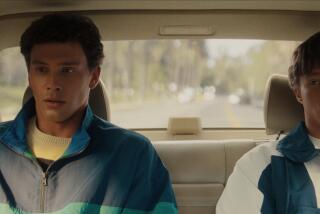Pastiche of ‘Killers’ Appeals to Media-Raised Generation
In “Natural Born Killers,” Mickey and Mallory, psycho-lovers severely abused as children, embark on a nightmarish killing spree and become darlings of the tabloid media, defending their actions better than the journalist, the police officer and the warden who want to exploit them. (Rated R)
*
If, as this movie proposes, the general public has an adolescent fascination with violence, it’s not surprising that adolescents would be fascinated by this movie.
Fast-cut MTV-style, with fantasy sitcoms and animated cartoons of the killers’ horrific lives, it offers a Generation X tour of life’s sewer--violent sex and mindless mass murders, starting off with Mallory’s parents--with cynicism the only lesson. Footage of O.J. Simpson, the Menendez brothers, Tonya Harding and others drives home the point at the end.
(Don’t even bother asking how 15- and 16-year-olds get into a movie supposedly restricted to those 17 and older. They just buy a ticket and walk in. What is less understandable is why adults bring even younger children to an ultra-violent movie that so clearly pushes the limits of an R rating.)
The movie left some teens wordless beyond “weird” and “gross.” But others were impressed with director Oliver Stone’s technical creativity and his pointed jabs at the media-drenched culture in which they’ve been raised. All said they liked it, even if they felt like taking a shower afterward and were confused about the ultimate message.
“It was a good movie for the kind of movie it was supposed to be,” said Renata Bacellar, 15. “It’s not exactly like a great movie, like something you would really want to watch, but if you’re going to watch something crazy like that, they did it well.”
She and her friend Stephanie Chaffin, also 15, said if there was a point, they didn’t get it. The scenes that stood out in their minds were the murders, but they didn’t think the film would provoke nightmares.
“It’s just a movie,” Stephanie said.
Bill Bacellar, 16, and Gavin Fields, 17, said at times they felt the movie flowed aimlessly.
But while Bill called it an “A-grade” movie that realistically portrayed media exploitation of the public’s love of violence, his friend called it “overrated.”
“I thought it was going to be better than it was,” Gavin said. “I liked it and all, but I read in the newspaper that it was going to be ‘audacious filmmaking.’ It wasn’t as spectacular as I thought it was going to be.”
His reaction to the unusual mixing of styles, distortions, black-and-white with color and news clips was mixed.
“The part was good at the end when they showed O.J. Simpson and Lorena Bobbitt. It sort of gave me chills, you know, like he’s condemning our society and how we’re exploiting these things,” Gavin said.
But sometimes the style confused the point, he added.
“I was trying to watch the movie and see what he was getting at, like symbolism, or double meaning. I couldn’t figure it out too much. Like when he did the murders and there was a cartoon, did he think he was seeing himself as someone in a comic book, or was it like something in a comic book influenced him to do these things?”
Nailing the root of the controversy over the movie, he also questioned the integrity of a media project full of violence that criticizes violence in the media.
“In the movie, it was saying how our society exploits violence all the time, but I was thinking: Doesn’t the movie itself exploit violence?”
Despite its intellectual remove from your standard muscle action flick, the boys said their adrenaline was flowing afterward.
“When I walked out of the theater, I wanted to go shoot somebody or something,” Gavin said. “Not really,” he added.
Bill agreed. “You feel like a rage going.”
The movie’s overall message about violence was unclear, they said. Mickey and Mallory continue to kill without remorse or regret, in the end, leaving a trail of 50 dead.
“It’s hard to say,” Gavin said. “It’s so sarcastic all the time.”
Said Bill, “It doesn’t give you this direct, direct message. The viewer has to figure that out.”
More to Read
Only good movies
Get the Indie Focus newsletter, Mark Olsen's weekly guide to the world of cinema.
You may occasionally receive promotional content from the Los Angeles Times.










